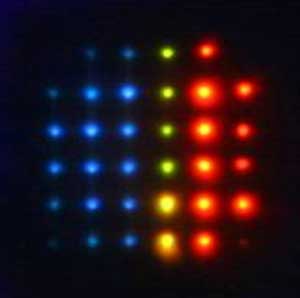Researchers at Cambridge University's Centre of Molecular Materials for Photonics and Electronics (CMMPE) are developing high-colour-resolution laser displays using liquid-crystal laser technology.
They recently demonstrated a 2D liquid-crystal laser array, which emitted red, green and blue colours simultaneously when optically pumped with a single 430nm source.
The researchers believe that such liquid-crystal lasers could be used to replace the individual RGB lasers that are currently required in emerging laser displays, leading to a reduction in materials and manufacturing costs.
The liquid crystal in the device sports a helical structure with a periodic refractive index and, combined with a fluorescent dye, the liquid crystal lases within a device of thicknesses of less than a human hair.
Unlike most conventional semiconductor lasers, the emission wavelength of the liquid-crystal laser can be dynamically tuned using an applied voltage that alters the degree of periodicity of the molecular structure. The emission can be chosen to be at any desired wavelength across the visible range through chemical control of the macroscopic material properties.
A gradient in the periodicity of the liquid-crystal structure can, therefore, be formed, which gives rise to simultaneous different emission wavelengths across the device.
Such liquid-crystal lasers are not merely restricted in their use to laser displays. Researchers at CMMPE are also developing applications for their use in infrared medical diagnostic tools, telecommunication devices and holographic projection.

Simultaneous red-, green- and blue-emitting liquid-crystal laser array




Glasgow trial explores AR cues for autonomous road safety
They've ploughed into a few vulnerable road users in the past. Making that less likely will make it spectacularly easy to stop the traffic for...